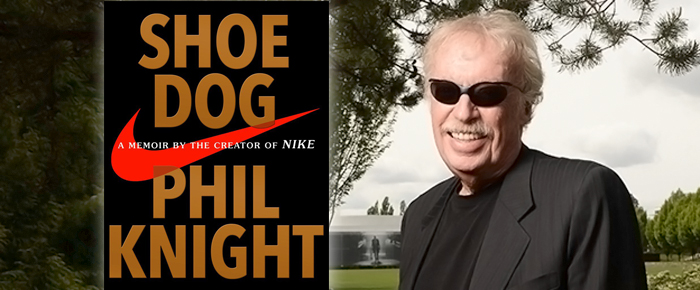
By Heidi Simmons
—–
“Shoe Dog”
by Phil Knight
Memoir
—–
Nike is one of America’s greatest companies. For a country driven by capitalism, you’d think starting a business would be easy. In Phil Knight’s Shoe Dog (Scribner, 400 pages), building a successful enterprise is anything but a fast-track to victory.
Author Knight starts his memoir after his graduation from Stanford University. It’s 1962. He’s 24, has a MBA and doesn’t know what to do next. So he moves back with his family to his childhood home in Oregon.
During a long morning run, Knight considered his options and decided whatever he was going to do, it had to be “play.” The concept that work could be like a sport or game became his “Crazy Idea.”
Knight was a good athlete, but never great. He competed on the track team for the University of Oregon. He loved sports and played them since he was a kid. His graduate lecture at Stanford was about developing athletic shoes. At the time, there were only a few “tennis” shoe manufacturers. Although he earned an “A” on his paper, his classmates were not interested.
Once Knight locked into his “Crazy Idea”, he thought he better travel the globe while he had time. He wanted to explore the great religions of the world and see their temples.
While Knight was in Japan, he made a deal with a shoe manufacturer to distribute their “Tigers” in the US. On the spot, Knight called his “company” Blue Ribbon for the award ribbons that hung in his bedroom at home.
He continued on his trip around the world. It was during his travels that he first saw the Greek, winged goddess of victory, Nike.
When he returned home, he partnered with his old coach and Olympic trainer Bill Bowerman, who was always designing and making improvements to running shoes.
Bowerman often tried his experimental shoes on Knight when he ran for the Oregon Ducks. (Better to test the shoes on a decent runner rather than your best runner.) Bowerman knew that if he could remove one-ounce from running shoes, it would be equal to eliminating 55 pounds over a mile. That would make his runners faster.
Knight gradually built a team of eccentric characters who all loved running and were sports fanatics. When Knight overheard an artist say she couldn’t afford to pay for school, he offered her a job. She went on to design the “fat check mark” – the Nike “swoosh.”
In 1964, selling Tigers out of the trunk of his Valiant, Knight made $8,000 the first year. Each year after, Blue Ribbon doubled its sales. However, there was a constant battle for money. For years, Knight had a day job to help make ends meet. Banks refused to advance him the cash needed even when it meant millions of dollars in potential sales.
After Knight made the in-roads and built a thriving athletic shoe industry across the nation with the Tiger brand, the Japanese company reneged on their deal. Then the Federal Government wanted $25 million in import tariffs. Blue Ribbon had no money. US businesses wanted Knight and his company out of the game, but instead Nike was born. There was intense competition. But Knight stayed in the race, powered through and endured, creating a new brand.
In 1980, Nike went public. Today, Nike has annual sales of $30 billion.
Shoe Dog is an exciting memoir. A “shoe dog” is someone who lives and breathes shoes. Told chronologically, the story moves through the history of the 1960s and ‘70s. I remembered when I got my first pair of Nikes in 1976. White nylon with a red swoosh and blue in the otherwise white sole. Before that I wore Tigers. Those Nikes were made to make a point to US officials.
This is such a thrilling read as Knight ticks off the years and keeps his business growing. It’s suspenseful as he struggles to make the company, as well as his family, function. Knight is an underdog and I was rooting for him and fascinated by how he and his people kept to their vision. Beyond tenacity, integrity and ambition, everyone at Blue Ribbon loved to run.
It helps that Knight writes well, at times even poetic. He often makes literary and philosophical references. Knight seems to be honest and forthcoming. He is humble and gives credit to the good people and fascinating characters around him. He admits to his flaws and allows others to make important decisions. Knight didn’t like the name “Nike,” nor did he like the logo. Good thing he had a dedicated team who insisted on using both.
Shoe Dog is filled with famous athletes and significant events. Knight even mentions going to the movies in Cathedral City and running into Bill Gates and Warren Buffet after seeing “The Bucket List.”
There are fun and sad moments and amazing twists and turns. I especially loved “employee #1” Jeff Johnson. What a terrific character. This book reads so well that at times I had to remind myself Shoe Dog is not a historical novel. I’m looking forward to the movie.
Nike is a part of our culture and a global brand. Phil Knight got a “Crazy Idea” and he ran with it – all the way to the finish line – and the bank!












































